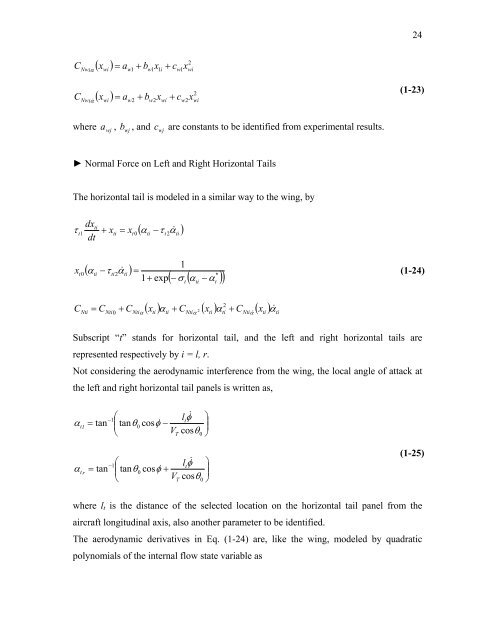- Page 1 and 2: An Investigation of Unsteady Aerody
- Page 3 and 4: iAcknowledgmentsAll that I struggle
- Page 10 and 11: Figure 3-19 Roll angle time history
- Page 12 and 13: 0( α )x static dependence function
- Page 14 and 15: 11 IntroductionThe atmospheric flig
- Page 16 and 17: 3aerodynamic forces in terms of the
- Page 18 and 19: 5another state-space representation
- Page 20 and 21: 7a nonlinear indicial response theo
- Page 22 and 23: 9Figure 1-2 Internal state-space va
- Page 24 and 25: 11representation, we write it expli
- Page 26 and 27: 13C& α cV() t = C ( α ) + C C ()
- Page 28 and 29: 15(a)(b)*Figure 1-3 Influence of th
- Page 30 and 31: 17( α )1x0 U eff=1+exp(1-13)[ −
- Page 32 and 33: 19tˆ =c2V, (1-17)c being a charact
- Page 34 and 35: 21representing forward and aft fuse
- Page 38 and 39: 25Ntiα2( x ) = a + b x c xC +tit1
- Page 40 and 41: 27The rolling moment of the aircraf
- Page 42 and 43: 29are the A-4 Skyhawk, F-4 Phantom,
- Page 44 and 45: 31Conventional wing rock is that oc
- Page 46 and 47: 33Figure 1-8 Crossflow streamlines
- Page 48 and 49: 35possible cases forC φ, where the
- Page 50 and 51: 37Figure 1-10 Roll angle time-histo
- Page 52 and 53: 39Figure 1-14 Rolling moment coeffi
- Page 54 and 55: 41Figure 1-15 C l vs. roll angle hi
- Page 56 and 57: 430.020-0.02C l-0.04-0.06-0.08φ =
- Page 58 and 59: 451.2.3 Analytical and Computationa
- Page 60 and 61: 47vertical fin inclusion, the oscil
- Page 62 and 63: 49Table 1-1 Geometrical and physica
- Page 64 and 65: 51Figure 1-22 Free to roll apparatu
- Page 66 and 67: 53Both of these problems make it di
- Page 68 and 69: 55experimental results the values o
- Page 70 and 71: 57► State equations:τdxi1,x+ xi=
- Page 72 and 73: 592.2 The Second Unsteady Aerodynam
- Page 74 and 75: 61With the help of the formulation
- Page 76 and 77: 63tunnel tests results shown in Fig
- Page 78 and 79: 65C2( ν ) = a + b ν c νN i 6 6 i
- Page 80 and 81: 67Figure 2-2 Static model responses
- Page 82 and 83: 69Figure 2-4 Variation of the norma
- Page 84 and 85: 71When the quasi-static sequences o
- Page 86 and 87:
73identification. The static data u
- Page 88 and 89:
752( x ) - 7.293 x - 5.427 xCN i= 0
- Page 90 and 91:
77Figure 3-1 Static normal force co
- Page 92 and 93:
Figure 3-3 Identified static values
- Page 94 and 95:
Figure 3-5 Rolling moment coefficie
- Page 96 and 97:
Figure 3-7 Rolling moment coefficie
- Page 98 and 99:
Figure 3-9 Rolling moment coefficie
- Page 100 and 101:
87with the roll angle, and attains
- Page 102 and 103:
890.060.04θ = 20 degModel response
- Page 104 and 105:
9140θ = 27 deg20φ, deg0-20-4015.6
- Page 106 and 107:
93C l0.150.1θ = 27 degModel respon
- Page 108 and 109:
95C l0.150.1θ = 38 degModel respon
- Page 110 and 111:
97100θ = 45 deg50φ, deg0-50-1000
- Page 112 and 113:
990.060.04θ = 45 degModel response
- Page 114 and 115:
101Table 3-1 Model parameters for t
- Page 116 and 117:
103Table 3-3 Continuation of Table
- Page 118 and 119:
105Table 3-6 Continuation of Table
- Page 120 and 121:
107Table 3-9 Continuation of Table
- Page 122 and 123:
109q, r, the Euler angles time rate
- Page 124 and 125:
1114.3 Results of the SimulationsTh
- Page 126 and 127:
Figure 4-2 Phase-plane of the simul
- Page 128 and 129:
Figure 4-4 Phase-plane of the simul
- Page 130 and 131:
Figure 4-6 Phase-plane of the simul
- Page 132 and 133:
Figure 4-8 Phase-plane of the simul
- Page 134 and 135:
121Considering these characteristic
- Page 136 and 137:
123[10] Jones, R. T., “The Unstea
- Page 138 and 139:
125[28] Goman, M. G., Stolyarov, G.
- Page 140 and 141:
127[45] Nguyen, L. T., Yip L., Cham
- Page 142 and 143:
129AppendicesAppendix AA.1 The Conv
- Page 144 and 145:
131u = V cosθ 0v = Vsinθ0sinφw =
















